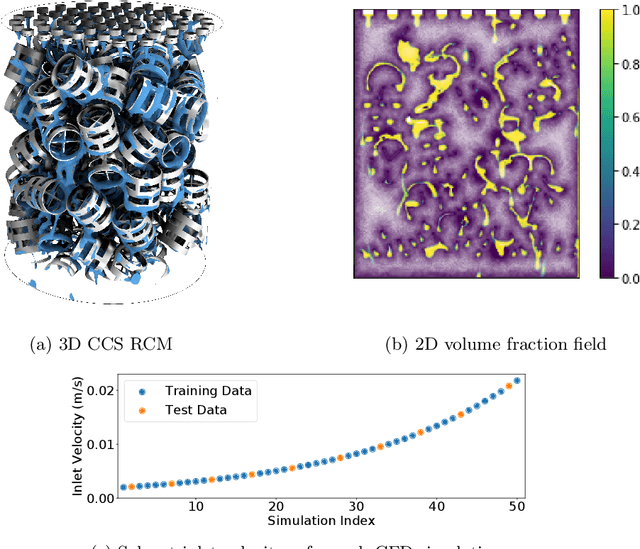Sam Nguyen
Latent Space Simulation for Carbon Capture Design Optimization
Dec 22, 2021



Abstract:The CO2 capture efficiency in solvent-based carbon capture systems (CCSs) critically depends on the gas-solvent interfacial area (IA), making maximization of IA a foundational challenge in CCS design. While the IA associated with a particular CCS design can be estimated via a computational fluid dynamics (CFD) simulation, using CFD to derive the IAs associated with numerous CCS designs is prohibitively costly. Fortunately, previous works such as Deep Fluids (DF) (Kim et al., 2019) show that large simulation speedups are achievable by replacing CFD simulators with neural network (NN) surrogates that faithfully mimic the CFD simulation process. This raises the possibility of a fast, accurate replacement for a CFD simulator and therefore efficient approximation of the IAs required by CCS design optimization. Thus, here, we build on the DF approach to develop surrogates that can successfully be applied to our complex carbon-capture CFD simulations. Our optimized DF-style surrogates produce large speedups (4000x) while obtaining IA relative errors as low as 4% on unseen CCS configurations that lie within the range of training configurations. This hints at the promise of NN surrogates for our CCS design optimization problem. Nonetheless, DF has inherent limitations with respect to CCS design (e.g., limited transferability of trained models to new CCS packings). We conclude with ideas to address these challenges.
Grid Search Hyperparameter Benchmarking of BERT, ALBERT, and LongFormer on DuoRC
Jan 15, 2021



Abstract:The purpose of this project is to evaluate three language models named BERT, ALBERT, and LongFormer on the Question Answering dataset called DuoRC. The language model task has two inputs, a question, and a context. The context is a paragraph or an entire document while the output is the answer based on the context. The goal is to perform grid search hyperparameter fine-tuning using DuoRC. Pretrained weights of the models are taken from the Huggingface library. Different sets of hyperparameters are used to fine-tune the models using two versions of DuoRC which are the SelfRC and the ParaphraseRC. The results show that the ALBERT (pretrained using the SQuAD1 dataset) has an F1 score of 76.4 and an accuracy score of 68.52 after fine-tuning on the SelfRC dataset. The Longformer model (pretrained using the SQuAD and SelfRC datasets) has an F1 score of 52.58 and an accuracy score of 46.60 after fine-tuning on the ParaphraseRC dataset. The current results outperformed the results from the previous model by DuoRC.
Attend and Decode: 4D fMRI Task State Decoding Using Attention Models
Apr 10, 2020



Abstract:Functional magnetic resonance imaging (fMRI) is a neuroimaging modality that captures the blood oxygen level in a subject's brain while the subject performs a variety of functional tasks under different conditions. Given fMRI data, the problem of inferring the task, known as task state decoding, is challenging due to the high dimensionality (hundreds of million sampling points per datum) and complex spatio-temporal blood flow patterns inherent in the data. In this work, we propose to tackle the fMRI task state decoding problem by casting it as a 4D spatio-temporal classification problem. We present a novel architecture called Brain Attend and Decode (BAnD), that uses residual convolutional neural networks for spatial feature extraction and self-attention mechanisms for temporal modeling. We achieve significant performance gain compared to previous works on a 7-task benchmark from the large-scale Human Connectome Project (HCP) dataset. We also investigate the transferability of BAnD's extracted features on unseen HCP tasks, either by freezing the spatial feature extraction layers and retraining the temporal model, or finetuning the entire model. The pre-trained features from BAnD are useful on similar tasks while finetuning them yields competitive results on unseen tasks/conditions.
 Add to Chrome
Add to Chrome Add to Firefox
Add to Firefox Add to Edge
Add to Edge